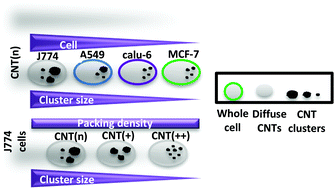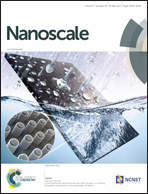Spatially-resolved profiling of carbon nanotube uptake across cell lines†
Abstract
The internalisation and intra-cellular distribution of carbon nanotubes (CNT) has been quantitatively assessed using imaging flow cytometry. Spatial analysis of the bright field images indicates the presence of a small sub-population (5% of cells) in which the internalised CNTs are packed into pronounced clusters, visible as dark spots due to strong optical scattering by the nanotubes. The area of these spots can be used as a label-free metric of CNT dose and we assess the relative uptake of charge-neutral CNTs, over a 24 hours exposure period across four cell types: J774 mouse macrophage cells, A549 and Calu-6 human lung cancer cells, and MCF-7 human breast cells. The relative dose as indicated by the spot-area metric closely correlates to results using the same CNT preparation, conjugated to a FITC-label and shows pronounced uptake by the J774 cells leading to a mean dose that is >60% higher than for the other cell types. Spatial evaluation of dosing clusters is also used to quantify differences in uptake by J774 cells of CNTs with different surface functionalisation. While the percentage of CNT-cluster positive cells increases from 5% to 19% when switching from charge-neutral CNTs to poly-cationic, dendron functionalised CNTs, the single cell level analysis of internalised clusters indicates a lower dose per cell of poly-cationic CNTs relative to the charge-neutral CNTs. We concluded that there is dose homeostasis i.e., the population-averaged cellular dose of CNTs remained unchanged.



 Please wait while we load your content...
Please wait while we load your content...